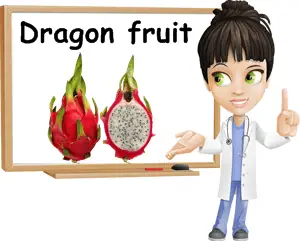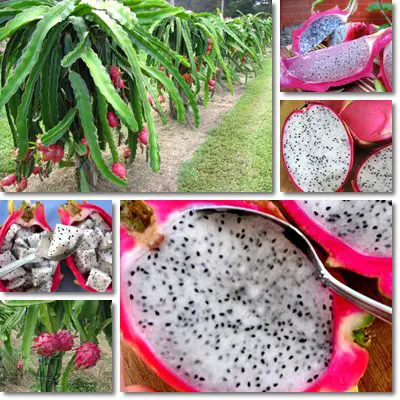White-fleshed pitahaya is the fruit of a tall, torch-like cactus in the Hylocereus genus. This jazzy tropical fruit is best known as the Dragon fruit (Hylocereus undatus), a pink-skinned variety with mildly sweet white flesh. Dragon fruit are not only dainty, but also low in fat and calories and full of antioxidants. The fruit is particularly rich in vitamin C and heart-friendly fatty acids such as Omega-6 and Omega-9.
Preliminary research suggests that eating the fruit stimulates toxin elimination and helps ease and prevent constipation. The healthy unsaturated fats in the fruit support brain and nervous system health and boast antioxidant properties. Moreover, regular consumption contributes to good immunity as a result of its vitamin C content and helps lower unhealthy cholesterol levels, further benefiting cardiovascular health.

What does Dragon fruit look like?
There are several different varieties that distinguish themselves primarily through skin and flesh color. Overall, the fruit has an oval shape and bright-colored skin that may be pink, red, yellow or orange. It has what looks like green scales which give it a sort of fruity ball of fire appearance. The flesh can be pink, white or yellow and is full of small, dark seeds distributed randomly all over the fruit, making it look somewhat like kiwifruit or prickly pear (see benefits of prickly pear). Different combinations of skin and pulp color are possible, adding to the popularity of the tropical fruit.
Varieties of dragon fruit:
There are three main types of Dragon fruit:
- Yellow-skinned, white-fleshed Dragon fruit or white pitahaya (Hylocereus megalanthus).
- Pink-red skinned, white-fleshed Dragon fruit (Hylocereus undatus).
- Pink-red-skinned, red-fleshed Dragon fruit (Hylocereus costaricensis).
What does Dragon fruit taste like?
All three varieties boast a mildly sweet taste, reminiscent of not very ripe watermelons. They can weigh between 200 g and 1.000 g, but are generally somewhere in the middle.
The present article deals with the properties and health benefits of the white-fleshed, pink-skinned variety, the most common of the three.
Dragon fruit can be eaten both fresh and dried and remain equally nutritious. Because the seeds of the fruit are spread throughout the flesh and thus cannot be taken out, the fruit is eaten whole, pulp and seeds. The peel is not edible.
Because it does not have a unique taste or particular aroma like other fruits, it is often combined with other more flavorful fruit options in salads.
As far as its health benefits are concerned, see below what are the properties and health effects that stand out the most.
See also : How Long Does Dragon Fruit Last?

What are the benefits of Dragon Fruit?
Good for cardiovascular health
Eating white-fleshed pitahaya can help maintain low cholesterol levels and keep blood vessels elastic. Dragon fruit are low in calories and cholesterol, making them ideal if you are watching your weight or if you are under any cholesterol restrictions. The seeds indeed contain small amounts of saturated fats in the form of myristic acid, palmitic acid, stearic acid and cis-vaccenic acid.
However, dragon fruits contain mostly heart-friendly unsaturated fatty acids such as palmitoleic acid (an Omega-7), oleic (an Omega-9) and linoleic acid (an Omega-6), which offer antioxidant protection to blood vessels and protect against cardiovascular disease. Moderate consumption of fats from any source, animal or plant-based, is advised.
Benefits for immunity
Dragon fruit helps prevent scurvy, boosts immunity and offers strong antibacterial protection due to a relatively good vitamin C content. Depending on soil quality, which significantly influences nutrient value, one small Dragon fruit can provide about 50% of the daily recommended vitamin C content. Vitamin C is a great immunity booster and helps reduce both the frequency and severity of colds and respiratory infections in general.
Good source of vitamins
White-fleshed Dragon fruit are a good source of beta-carotene as well as vitamins B1, B2 and B3. In addition to promoting eye health, the fruit ensures good energy levels and supports the activity of the digestive system.
Detoxification food
As ongoing research suggests, Dragon fruit is a potent detoxifying food. The seeds are a good source of dietary fiber and thus stimulate toxin excretion and help cleanse the intestines from waste material and even heavy metals which can affect colon health. By relieving constipation naturally, the fruit maintains digestive system health.
Antioxidant benefits
Dragon fruit contain a powerful antioxidant known as phytoalbumine. Research suggests that phytoalbumine can efficiently stop free radical action and thus prevent cancer-causing cell mutations. When cell damage from free radicals accumulates, cells mutate and may start to multiply uncontrollably, a process known as cancer.
For this reason, it is important to include in your diet antioxidant-rich foods such as Dragon fruit as well as berries, nuts and seeds.
As healthy as they may be, the fruit may be relatively hard to find outside their area of cultivation. The cactus producing the fruit thrives in arid tropical and subtropical regions, where there is little rainfall and plenty of sunlight.
One night per year, the cacti bloom. Beautiful, fragrant, creamy white flowers blossom and wither just before dawn. It is a magical sight which leaves one wondering about what may lie within the brightly-colored pinkish Dragon fruit.
